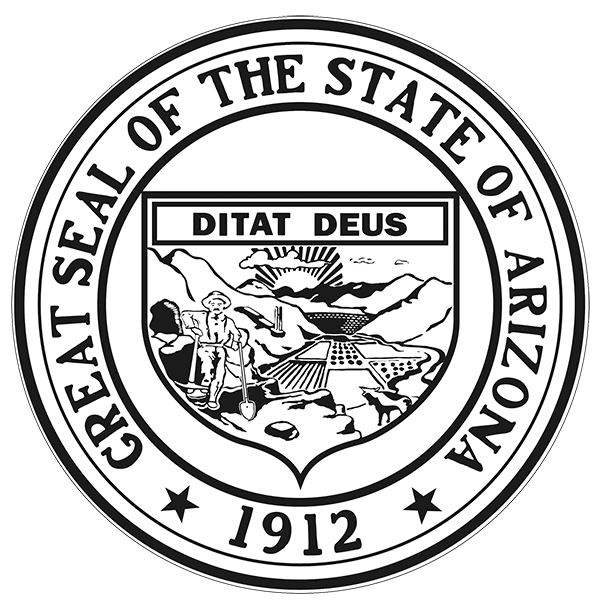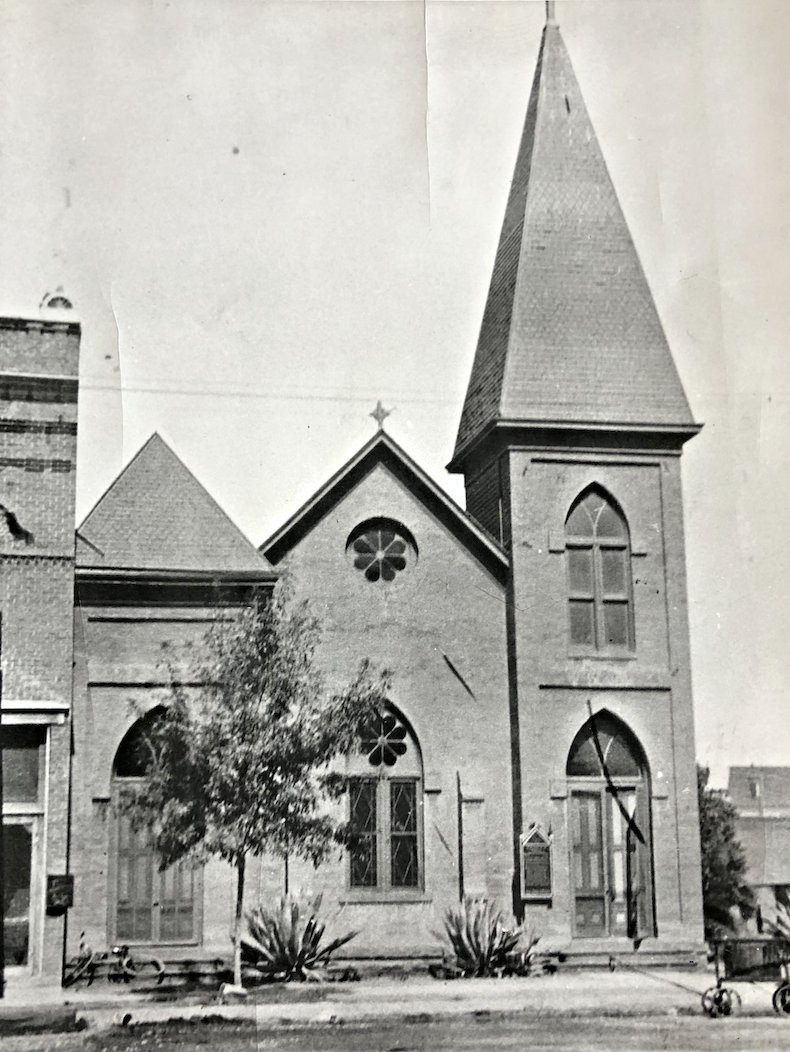Centennial Timeline
Timeline Color Key | Trinity Cathedral (Blue) | City of Phoenix, AZ (Brown)
Before 1900 | 1900-20 | 1920-40 | 1940-60 | 1960-80 | 1980-00 | 2000-20 | 2020-40 & Beyond
1900-20
1900
City accesses unincorporated lands; area increases from a half-acre to over 2 acres.
1900
The first automobiles arrive in the city.
1901, February 25
The State Capitol building is dedicated, built at a cost of $130,000.
1901
Drought hits the city.
1903
Construction begins on the Theodore Roosevelt Dam.
1905
The Salt River overflows its banks.
1906
Gambling is outlawed in the city.
1906
Rev. Julius Walter Atwood becomes Minister-in Charge at Trinity Mission and later Archdeacon of the Missionary District of Arizona. Rev. Atwood and his family had moved to Tucson in 1904 to find a place where his wife, Anna, could receive care for her tuberculosis. Her illness got worse in Phoenix as the weather got hotter. The family moved to Colorado Springs for care there, but sadly, she died shortly thereafter. He returned to Phoenix with their daughters.
1907
The YMCA raises $100,000 to construct a building in town.
1908
The Salt River overflows its banks.
1908
Bishop Kendrick changes the status of Trinity from Mission to a Parish. The new Parish Vestry elects Rev. Atwood as its Rector. Rev. Atwood establishes a Chapter of the Brotherhood of Saint Andrew, a national church men’s organization, and forms The Board of Visitors, a group of women who provide assistance to those suffering from tuberculosis. He also hires a young seminarian graduate, Bertrand Richard Cocks to be his Curate. Cocks and his wife, Mary, both had considerable experience in tuberculosis treatment in California.
1909
The Central Avenue bridge over the Salt River is approved.
1910
Speed limit is increased to 12 mph in city limits. There are 329 licensed cars in the city.
1910
The number of African Americans in Phoenix grows to 328. This relatively small portion of this population had a high percentage of home ownership.
1910
Phoenix city schools establish an official segregation policy.
1910
Guidelines concerning surface water rights are established by the Kent decree.
1910
Bishop Kendrick approves Trinity’s purchase of lots on Van Buren and 18th Streets for a tubercular treatment center. He also ordains Bertrand Cocks as Deacon and then priest over the next two years. Bertrand and Mary build a “tent city” there, first as St. Luke’s Sanitorium, which would later become St. Luke’s Hospital. Cocks became a Canon of Trinity Cathedral and Superintendent of St. Luke’s, positions he held until his death in 1941, when he was honored by both his church and the City of Phoenix.
Photo: The first administration building at St. Luke’s Sanitorium, 1907.

1910
The General Convention of the Church abolishes the Missionary District of New Mexico and Arizona and creates a separate district for each territory. Bishop Kendrick decides to remain in New Mexico as its Missionary Bishop. The House of Bishops elects Julius Walter Atwood as Missionary Bishop of Arizona. Trinity’s Vestry asks Bishop Atwood to continue as their Rector. He agrees to do so.
Photo: Bishop Julius W. Atwood, Rector and Archdeacon, 1906-1911; Bishop, 1911-1925.

1911
The Center Street (also known as Central Avenue) Bridge across the Salt River opens.
1911
After his Consecration in Boston, Bishop Atwood returns to Phoenix with blueprints for a series of buildings to serve as the Cathedral Complex. Prepared by the Boston Architectural Firm of Shepley, Rutan, and Coolidge were drawings for a Bishop’s Residence, and three buildings arranged to form a quadrangular space, or Close: a Cathedral Church, a Cathedral House, and a future Christian Education Building. Their architectural design was to be Spanish Colonial style with Mexican elements.
1912, February 14
Arizona becomes the 48th state of the United States.

1912
Phoenix becomes the state capital.
1912
Women in Arizona are granted the right to vote.
1912
The first Mormon Church meeting in Phoenix takes place.
1912
A Study Committee offers both the Bishop and the District Convocation the “Institutes of the Pro Cathedral”. Both accept the “Institutes”. Bishop Atwood resigns as Rector and, with the Vestry’s unanimous approval, paves the way for William J. Scarlett to become the First Dean of Trinity Cathedral.
Photo: Dean William J Scarlett served from 1912 to 1922.

1913
The city adopts a council-manager form of government (previously mayor-council), becoming one of the first cities in the country to adopt this form of government.
1913
Thirty-five percent of votes cast in Phoenix are cast by women.
1913
The city has 646 registered automobiles.
1914
The first Lutheran church in Phoenix and Arizona opens.
1914
Arizona votes to ban alcohol.
1914
A site for a new church campus is found on West Roosevelt Street with a wide frontage on Roosevelt Street west of Central Avenue.
1914
Fund raising for the construction of Trinity’s enlarged church was based on profits made on the sale of previously acquired lots on North Central, and on Washington and 2nd Avenue, which had all increased in value. The sale of these properties provided for beginning the construction of the new church.
Photo: Bishop Atwood at the cornerstone laying at Cathedral and Cathedral House buildings, October 31, 1915. Vice President Thomas R. Marshall was likely in this picture. He was principal speaker at the event and served with President Woodrow Wilson.

1915
Dean Scarlett also serves as a member of the Arizona State Board of Regents; and Scoutmaster of Troop 2, Theodore Roosevelt Council, Boy Scouts of America. The young Barry Goldwater was a member of this troop.
1915
St. Mary’s Basilica, on 3rd and Van Buren Streets, is dedicated. It replaces the adobe structure built in 1881. It is the oldest Roman Catholic church in the greater Phoenix area.
1915
The city’s first sewer treatment plant is completed.
1915
Trinity’s Junior Guild establishes the Phoenix Day Nursery for the children of working women in need of workday childcare during World War I. This program continues as a part of the non-profit, A New Leaf.
1915
Construction begins for a Cathedral House on the Roosevelt and Central campus. Construction of the Cathedral would begin five years later.
1915, December 15
The last Sunday Services take place in the Washington Street and 2nd Ave church.
Photo: Trinity Episcopal Church on Washington Street and 2nd Avenue.

1915, December 25
The first service in the nave of the newly built Cathedral House at Central and Roosevelt takes place, and the Sanctuary Choir played an important role in leading worship in Trinity’s new home. That building now houses the Olney Gallery.
Photo 1: Cathedral house was the first building of Trinity Church at Roosevelt and Central.
Photo 2: The Sanctuary Choir in Nave, 1915. The nave floor was under ground level.


1917
The Salt River Water Users Association gains control of the Salt River Project.
1917
Migrant workers from Mexico are brought in to pick cotton.
1918, Spring
The Bishop’s House is completed. It is west of the planned Cathedral.
1918
The Great Influenza pandemic affects a significant portion of the population.
1919
In anticipation of the upcoming U.S. Census, the city votes to extend the city limits.

